|
|
 |
 Home > Hotel & Tour > Tour Information Home > Hotel & Tour > Tour Information |
 |
Tour Attractions |
A variety of optional tours will be prepared for participating delegates and accompanying persons who wish to enjoy some of Jeju’s many attractions. The tours will be available for booking through the on-line reservation. |
 |
Hallim Park |
Hallim Park, located western 33km away from Jeju-si and west of Mt. Hallasan along the beach in Hallimeup, is one of the most popular tourist spots on Jeju Island. Hallim Park, almost 100 thousand square meters, has a variety of gardens that can be enjoyed in any season. Visitors can enjoy checking out Palm Tree Road, Jeju Stone and Bonsai Garden, Water Garden, Subtropical Botanic Garden and much more. The most famous tourist sites in Hallim Park are Hyeopjaegul and Ssangyonggul Caves known to be the only two-dimensional caves in the world. In addition, a folk village, children's amusement park and outdoor resort facilities make it enjoyable for both children and adults.
|
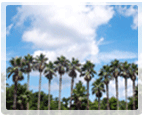 |
|
|
|
 |
Yongmeori Cliff |
There is a rocky hill called Yongmeori because it is shaped like the head of a dragon entering the water. It is composed of layered sandstone and visitors marvel at this uniquely beautiful coastline.
Hamel monument tombstone can be seen on the way to the shore. To recognize Hamel s achievement in Korea and advance friendship between South Korea and Netherlands, it was erected by Korea International Culture Society and Netherlands Embassy to South Korea on April 4th, 1980. |
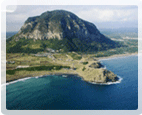 |
|
|
|
 |
Songak Mountain |
Mt. Songak is situated southwest of Mt. Sanbang, overlooking the sea with a group of peaks.With Mt. Halla far away, there is a small mountain. To the east, Dragon Head cliff and Hyeongje Island are easily visible. In addition, Korea southernmost island, Mara Island, can also be spotted. The Marine corps training in the water looks as if seals are swimming. |
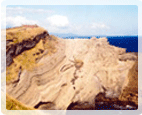 |
 |
|
 |
Oeodolgae |
The absence of a life partner led to irresistible yearning and finally caused her to become a rock.
This is what Oeodolgae signifies - abandoned and separated from the headland.
With the unusual rocks surrounding the Haekum River at Namju and the Chilsipri coast of Seogwipo, the 20-meter stone pillar "Oeodolgae" stands out. Standing at the beautiful beach of Samebong Peak and located 2 km from the west of Seogwipo, it was formed by volcanic activity at the same time as Jeju Island 1.5 million years ago. A group of pine trees inhabit the top of the pillar.
Oedolgae was named for its isolated location on the sea. It is also called Grandmother rock (Halmangbawi) as legend has it that an old woman waited for her husband to return from a fishing trip. When he didnt come back, she became a rock. On the tip of the rock, some trees and grasses grow, resembling human hair. It will givfe you the impression that the old woman forehead, sorrowful eyes and nose can be faintly seen on the left side of the rock. The open mouth will make you feel like the old woman is calling for her husband.
There is a rock right under the Oedolgae that looks like it is floating. It is said that the rock is her husband body before she become a stone pillar. Spreading like a folding screen, the oddly-shaped Fairy Rock (Seonnyubawi) cliff surrounds the rock as if it is trying to embrace the stone couple. |
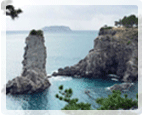 |
|
|
|
 |
Cheonjiyeon Waterfall |
The waterfall falls from a precipice with thundering sounds, creating white water pillars. It has the name Cheonjiyon, meaning ‘the heaven and the earth meet and create a pond’. At 22 m in height and 12 min width, the waterfall tumbles down to the pond to produce awe-inspiring scenery. The valley near the waterfall is home to Elaeocarpus sylvestrisvar, ellipticus, which is Natural Monument No. 163, Psilotum nudum, Castanopsis cuspidatavar.sieboldii, Xylosma congestum, Camellia and other subtropical trees. This place is also famous as home to the eel of Anguilla mauritiana, whichis Natural Monument No. 27 and is active primarily at night. |
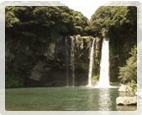 |
|
|
|
 |
Soesokkak |
The Soesokkak estuary is a special place, as it’s where the freshwater of the river meets the ocean. The water here is crystal clear and even from far above, you can see right down to the bottom of the water. The water and the surrounding mountains and rocks are very picturesque. Taking a ride on a teu is a relaxing way to appreciate the beauty of the Soesokkak area before starting your walk. |
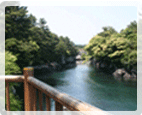 |
|
|
|
 |
Namwon Seaside |
In the past the locals named it ‘Keuneong’ because the area resembled a hill of gigantic rocks that was opening its mouth to swallow up the beautiful surroundings. The promenade winds its way along the coast where the waves crash against oddly shaped black lava rocks. This wild, picturesque promenade is a fitting ending to the day’s walk through some of Jeju’s most beautiful scenery. |
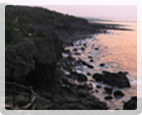 |
|
|
|
 |
Jusangjeolli |
The columnar joints are situated at seashore east Jungmun Tourism Complex. Black hexagonal stone pillars are piled on top of each other; they unfold like a folding screen as if a god elaborately piled up blocks of stone. The sound of the waves crashing into the rocks is remarkably refreshing. At the Daepo Columnar Joints, visitors can feel the mightiness and exquisiteness of the nature. It was designated as Cultural Property No. 50 by the Jeju Government.
Standing before the spectacular pillar-shaped joints, you feel as if you were listening to a poignant story of a stonecutter in bursts of white foam. When the tide is high, they jump up to 20 meters high as if lava were spouting. Thanks to its dramatic scenery, it stands in the spotlight for tourists on a theme tour.
The columnar joint is a pillar-shaped joint that can be commonly seen in basalt-covered areas. The rocks are hexagonal polygons. It is a result of volcanic activities; thick lava flowing from the mouth of a volcano cools abruptly down and contracts. The Daepo Columnar Joint is 30-40 m high and has a width of 1 km. It is the largest of its kind in Korea.
The place is part of Jungmun-dong, Seogwipo-si and called "Jisatgae Rock", named after the old name of Jungmun-dong "Jisatgae". |
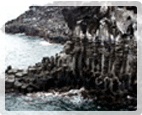 |
|
|
|
 |
Jeongbang Falls |
Jeongbang Falls, located in Donghong-dong, Seogwipo City, is one of the top three waterfalls in Jeju along with Cheonjiyeon Falls and Cheonjeyeon Falls. This water is the only one falling directly to the sea in Korea. The 23 m-high waterfall has two streams of water. It produces the brisk sounds of water falling along the black wall, creating a splendid scene along with the ocean. Moreover, the neighboring precipitous cliffs and the stately old trees add to the unique scenic view of the waterfall. It has been selected as one of the ten wonders of Jeju and called "Jeongbang Hapoki". They say that letters "Seo Bul Gwa Cha" are inscribed on the wall of the waterfall. A Chinese scholar named Seo Bul was ordered by the First Emperor of China to seek the herb of eternal youth. Unfortunately, he failed in his quest. On his way back home, he happened to see the waterfall and was mesmerized with its beauty. He inscribed "Seo Bul Gwa Cha"on the cliff, but since there is no vestige of the letters now, it might be just a legend.
It takes about five minutes to step down from a parking lot to the waterfall. |
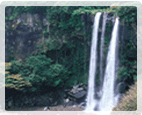 |
|
 |

|
|
|